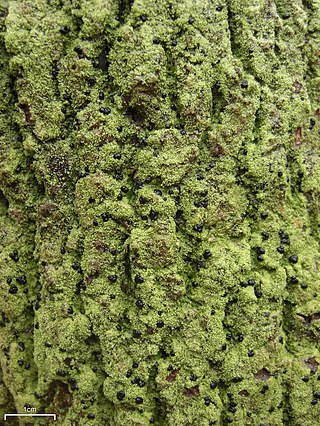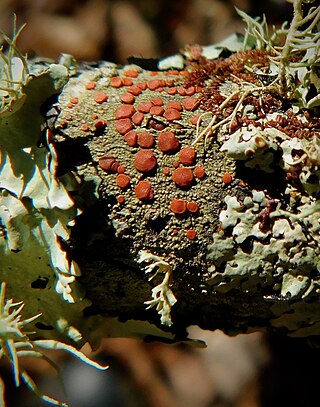NVC community CG7 is one of the calcicolous grassland communities in the British National Vegetation Classification system. It is one of three short-sward communities associated with heavy grazing, within the lowland calcicolous grassland group, and is regarded as the eastern counterpart of "typical" chalk grassland.

The Ramalinaceae are a family of lichenized fungi in the order Lecanorales. The family name is synonymous with the name Bacidiaceae. Species of this family have a widespread distribution.

Bacidia is a genus of lichen-forming fungi in the family Ramalinaceae. The genus was circumscribed by Giuseppe De Notaris in 1846.
Crustospathula is a genus of five species of crustose lichens in the family Malmideaceae. They are characterized by their stalked and sometimes branched cartilaginous soredia and Bacidia-like apothecia.

Combe Wood and Linkenholt Hanging is a 106.5-hectare (263-acre) biological Site of Special Scientific Interest south of Hungerford in Berkshire. It is in the North Wessex Downs, which is an Area of Outstanding Natural Beauty.
Antonín (Toni) Vězda was a Czech lichenologist. After completing a university education that was postponed by World War II, Vězda taught botany at the Czech University of Life Sciences. In 1958, he was dismissed from his university position as a result of the restrictions placed on academic freedoms by the communist regime in power. He eventually was hired as a lichen researcher by the Czechoslovak Academy of Sciences, who allowed him to work from his apartment, which served also as an office and herbarium.
Aquacidia is a genus of lichen-forming fungi in the family Pilocarpaceae. It has three species, which occur in Europe and North America. The genus was circumscribed in 2018 by André Aptroot to contain a small group of Bacidia species that formed a distinct lineage in the Pilocarpaceae. The type species is Aquacidia trachona, a lichen that was originally described in 1803 by Erik Acharius as Verrucaria trachona. The genus name Aquacidia refers to the habitat of the species, which is typically on rocks near water. Lichens in this genus can form thalli that cover vast areas of substrate. For example, in Holland, the lichens can form large colonies in sheltered rock crevices between boulders in dikes.
Brasilicia is a genus of leaf-dwelling lichens in the family Pilocarpaceae. It has 6 species. The genus was circumscribed in 2008 by lichenologists Robert Lücking, Klaus Kalb, and Emmanuël Sérusiaux, with B. brasiliensis assigned as the type species. The genus was originally circumscribed as monotypic; Edit Farkas transferred five species to Brasilicia from Bacidia in 2015.
Zwackhiomyces polischukii is a species of lichenicolous (lichen-eating) fungus in the family Xanthopyreniaceae. It occurs in Ukraine, where it parasitises the crustose lichens Bacidia fraxinea and B. rubella.

Bacidina pycnidiata is a species of crustose lichen in the family Ramalinaceae. It is widely distributed in Europe and North Asia. It is characterised by its whitish or cream-coloured pycnidia with long and ostiolar necks.
Muellerella hospitans is a species of lichenicolous fungus in the family Verrucariaceae. It is known to infect the lichen Bacidia rubella.

Bacidia rubella is a species of corticolous (bark-dwelling), crustose lichen in the family Ramalinaceae.
Bacidia areolata is a rare species of corticolous (bark-dwelling) lichen in the family Ramalinaceae. Found in the Russian Far East, it was formally described as a new species in 2018 by Julia Gerasimova and Andreas Beck. The type specimen was collected by the first author from the Bolshekhekhtsirskiy State Natural Reserve, where it was found growing on the bark of Acer tegmentosum in a coniferous-broadleaf forest near a river. The lichen is only known to occur at the type locality. The species epithet areolata refers to the structure of the thallus, which is areolate.
Bacidia elongata is a species of corticolous (bark-dwelling) lichen in the family Ramalinaceae. Found in the Russian Far East, it was formally described as a new species in 2018 by Julia Gerasimova and Andreas Beck. The type specimen was collected by the first author from the Bolshekhekhtsirskiy State Natural Reserve, where it was found growing on the bark of Acer mono in a coniferous-broadleaf forest near a river. It has also been collected in Primorsky Krai. The species epithet refers to the wide zone of enlarged cell lumina along the edge of the exciple.
Bacidia kurilensis is a species of corticolous (bark-dwelling) lichen in the family Ramalinaceae. Found in the Russian Far East, it was formally described as a new species in 2018 by Julia Gerasimova, Aleksandr Ezhkin, and Andreas Beck. The type specimen was collected by the second author from Kunashir Island, where it was found growing on the bark of Salix udensis in a mixed conifer-broadleaf forest in a small river valley. The species epithet kurilensis refers to the island group where it was first documented. The lichen has a poorly defined, granular thallus, and a greenish hue in the epihymenium and excipulum edge.
Bacidia sachalinensis is a little-known species of corticolous (bark-dwelling) lichen in the family Ramalinaceae. Found in the Russian Far East, it was formally described as a new species in 2018 by Julia Gerasimova, Aleksandr Ezhkin, and Andreas Beck. The type specimen was collected by the second author near the Rogatka River in Yuzhno-Sakhalinsk, where it was found growing on the bark of Populus maximowiczii in a floodplain forest; it has only been documented from this location. The species epithet refers to its type locality.
Candelariella biatorina is a species of corticolous (bark-dwelling), crustose lichen in the family Candelariaceae. It is characterised by its distinct yellow hue and apothecia that are biatorine in form. The lichen grows on the trunks of various conifer species across the western United States, and in the Russian Far East.
Bacidia depriestiana is a sorediate crustose lichen that grows on the bark of Quercus alba along forested streambanks on steep slopes in the Southern Appalachian Mountains in the United States. First described in 2021, it has so far only been found in three locations, in Tennessee, North Carolina, and South Carolina.




